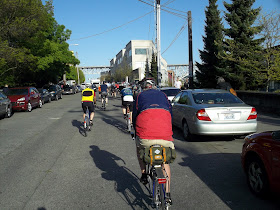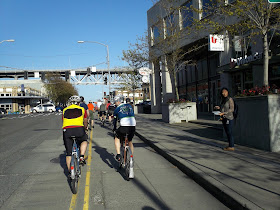If you are already totally comfortable shifting the gears on your bicycle, please feel free to skip this article -- it's not written for you. But if you're unsure of what those levers that change gears on your bike actually do and when you might want to use one lever over the other, read on. I was prompted to write these words by the dozens of very smart, intelligent people I've met over the years who have been baffled by bicycle shifting.
First off, let's talk about numbers. Numbers can be very useful in discussing things on a bicycle, but they can also be confusing because numbers in conversation are actually words and words have different meanings in different contexts. When I was a kid, when we talked about a "ten-speed bike", we were talking about a bike with ten different gear combinations. The bike had two gears up front, five in the back and front and rear derailleurs that were used to select the combination. Two times five is ten, so that's how the term "ten-speed" came about. Since then, the industrious folks in the bike industry have added more and more gears in the back and today when we speak of a "ten-speed drive-train" we are actually talking about ten gears in the back of a bicycle that may have two or three rings up front. I'm not sure that this is progress and I wrote
a rant on the subject a few years ago. It still is very common for a customer to ask me how many gears a bike has and the response I give most often is to say "a bunch." I then go on to explain the old and new "ten-speed" terminology and that while the bike they are looking at may have X different combinations of gears, it is most productive to look not at the sheer number of gear combinations, but at the range of the gears. Basically, as a rider you want your bike to have a low enough gear to get you up the hills without too much effort, a high enough gear to let you go fast without feeling "spun out" and a reasonable selection of gears in between. I sometimes add "for some people, that's all one gear!"
While some people can do fine with a single gear, most folks like to have some choices. One way to get that choice is to use a bike with an internally geared hub and a good discussion of hub gears can be found at:
http://hubstripping.wordpress.com/geared-hubs-vs-derailleur/
While hub gears and single speed bicycles have various advantages, derailleur gearing continues to be a versatile system for providing the rider with a wide range of light-weight, efficient gears. A good, geeky discussion of gear ranges can be found at:
http://web.archive.org/web/20090303203321/http://www.geocities.com/SiliconValley/Port/2945/Gears/Gears.html
The downside of all these gear combinations and math discussions is that people tend to get overwhelmed by numbers and worry that they're in the "wrong" gear. Over years of discussing gearing with anxious riders, I've found the following explanation of gearing to be helpful.
I'll use my own bike as an example, but any bike with a front and rear shifter will do. I begin by putting the nervous rider at ease by saying "just because you have a bunch of gears doesn't mean that you have to use them." And then I show them a bit of technique and give them one way to think about the gears. I've had many customers come back later and thank me because nobody ever took the time to explain gearing to them before. As bike geeks, it's hard sometimes to remember just how weird derailleur shifting really is.
In explaining the mechanics of shifting I say "bikes don't have clutches. You shift while pedaling, but it's best to shift with very little load on the chain. So you shouldn't be stomping the pedals but instead it should feel like the bike is going faster than you are. Mostly this means scanning the terrain ahead and downshifting
before the big hill. If the terrain gets too steep, too suddenly, push hard in your 'too hard gear' to build up a bit of speed, then ease up on the effort and downshift. If you can't do that, get off and walk. Soon you'll learn to anticipate the shift."
Here's how I explain the front shifter:
"You have either two or three chain rings up front. If you have two, think of them as low and high. If you have three, think of them as low, medium and high. Low is for going up hills and easy pedaling. High is for going fast or when you're feeling strong. If you have a middle gear, it's probably the one you'll be in the most. If your shifter has numbers on it, smaller numbers indicate the easier gears. I mainly use my front shifter based on terrain. If I'm going up, I'm using the little ring up front, the one numbered one. If I'm going down, I'm probably on the big ring, the one numbered three. If I'm just cruising around, I'm probably in my middle ring."
In talking about the gears in the back, my explanation goes like this:

"While I pick the gears up front based on terrain, I tend to pick the gear on the back based on how I feel. If things seem too easy, I pick a harder gear. On my shifter the gear is labeled with a higher number, indicating it's harder. If things seem a bit too hard, I move to a lower number, indicating an easier gear. Again, shift while pedaling but without much of a load. Pedal fast and hard for a few seconds, ease up (while still spinning) and shift. By the way, on the back the gears with fewer teeth are the harder ones, while up front it's opposite. You may have noticed that the front and rear shifters work the opposite on your bike. Yes, this is weird. On my bike I select my easy gear up front with my thumb and my easy gear in the back with my finger. I've done this basically forever (and bikes have been made this way damn near forever) and I've gotten used to it, but that doesn't make it less weird. You are not weird if this seems stupid to you."
Bikes are not as efficient if the chain is at an extreme angle and that is what happens if you are in the biggest ring up front and the biggest ring in the back or the smallest ring up front and the smallest ring in the back. It's often a gear combination like that people are talking about when they say you are in the "wrong" gear. It is wrong in the sense that you are sending mixed messages to the bike. On the one hand you are saying "I want to be in an easy gear" and literally on the other hand you are saying "I want to be in a hard gear". If your left shifter is displaying it's lowest number and your right shifter is displaying it's highest number (or vice versa) your chain may be rubbing and your bike may be complaining. With practice, you'll naturally learn to avoid these inefficient gear combinations and you'll almost instinctively select the right gear for where you are riding and how you are feeling.
The bicycle is a wonderful machine and the human mind and body are a wonderfully adaptive. With a bit of understanding and practice selecting the right gear becomes easy. What can be confusing at the start becomes simple with time. As easy as riding a bike.
Keep 'em rolling,
Kent "Mountain Turtle" Peterson
Issaquah WA USA

























































